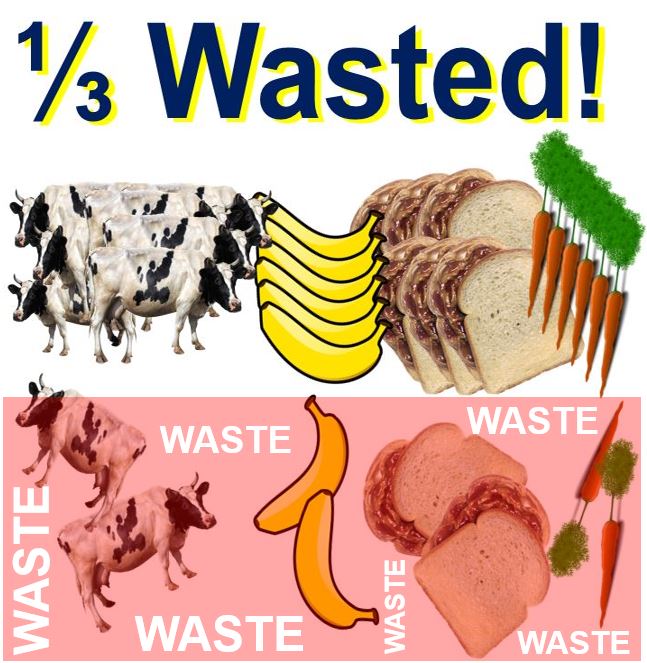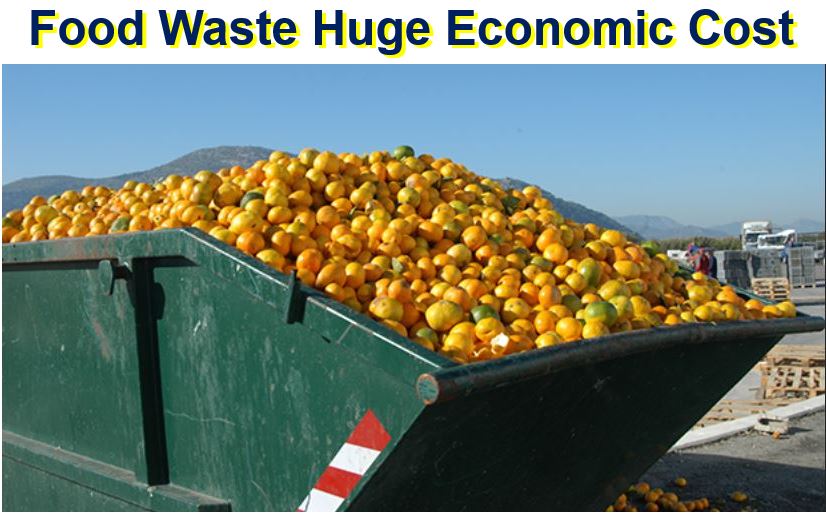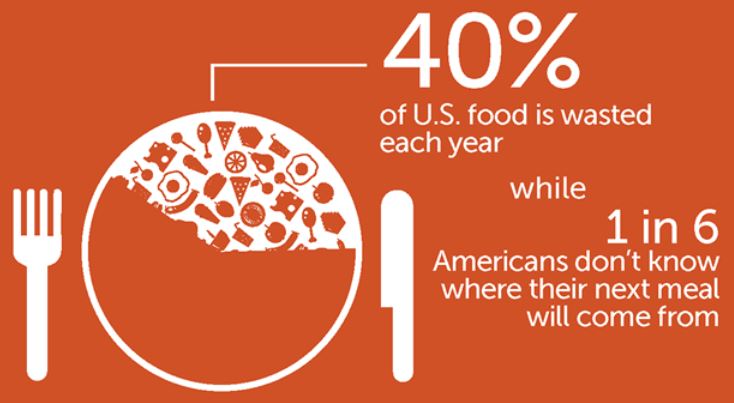Cutting down food waste would reduce greenhouse gas emissions and consequently help mitigate climate change, says a team of German scientists. Approximately one tenth of all greenhouse gas emissions worldwide that comes from farming could be traced back to food waste by mid-century, according to their study.
The researchers, from the Potsdam Institute for Climate Impact Research (Potsdam-Institut für Klimafolgenforschung – PIK), say they have provided for the first time comprehensive food loss projections for countries globally, and have also calculated related emissions.
They wrote about their study and findings in the academic journal Environmental Science & Technology (citation below).
 So much of the food we produce is wasted.
So much of the food we produce is wasted.
One third of food production wasted
Today, approximately one third of all the food we produce worldwide never finds its way onto our dinner plates, i.e. it is never consumed. This proportion will increase considerably if emerging economies like India and China adopt the eating habits of Western countries, their analyses show.
Reducing food waste would have two benefits: one we already know about, plus another that very few people are aware of – it would ensure food security and help mitigate dangerous climate change respectively.
Fighting hunger
Lead author, Ceren Hiç said:
“Reducing food waste can contribute to fighting hunger, but to some extent also prevent climate impacts like more intense weather extremes and sea-level rise.”
Despite food availability worldwide on average being higher than required in theory, some nations still have serious hunger or malnutrition problems.
Co-author Prajal Pradhan explained:
“At the same time, agriculture is a major driver of climate change, accounting for more than 20% of overall global greenhouse-gas emissions in 2010.”
“Avoiding food loss and waste would therefore avoid unnecessary greenhouse-gas emissions and help mitigate climate change.”
 Reducing food waste would have an enormous economic benefit too. According to the Food and Agriculture Organization of the United Nations: “The full economic, environmental and social costs of food waste amount to approximately 2.6 trillion US dollars annually.” (Image: fao.org)
Reducing food waste would have an enormous economic benefit too. According to the Food and Agriculture Organization of the United Nations: “The full economic, environmental and social costs of food waste amount to approximately 2.6 trillion US dollars annually.” (Image: fao.org)
Ms. Hiç and colleagues analyzed body types and food requirements for the past and several different future scenarios, accounting for demographic shifts as well as food demand and availability and associated greenhouse gas emissions.
We’re eating same amount but producing more food
They found that while the average food demand per person across the world remains virtually constant, over the past fifty years food availability has increased considerably.
Dr. Pradhan added:
“More importantly, food availability and requirement ratio show a linear relationship with human development, indicating that richer countries consume more food than is healthy or simply waste it.”
The researchers forecast that greenhouse gas emission linked to food waste could increase from the 0.5 Gigatons annually to 1.9-2.5 Gigatons of CO2 equivalents by the middle of this century.
Emissions from farming will become increasingly more important
Rapid population growth and lifestyle changes will probably produce an increase in emissions from agriculture alone of up to 18 Gigatons of CO2 equivalents by 2050, previous studies had already shown.
This means that emissions related to food waste are just the tip of the iceberg, the authors explained.
Dr. Pradhan said:
“However, it is quite astounding that up to 14 percent of overall agricultural emissions in 2050 could easily be avoided by a better management of food utilisation and distribution. Changing individual behavior could be one key towards mitigating the climate crisis.”
 Even in the rich countries, where food waste is colossal, there are people who struggle to get enough to eat. According to the Campus Kitchens Project: “Food waste (in landfills) quickly generates methane, helping to make landfills the third largest source of methane in the United States.” (Image: campuskitchens.org)
Even in the rich countries, where food waste is colossal, there are people who struggle to get enough to eat. According to the Campus Kitchens Project: “Food waste (in landfills) quickly generates methane, helping to make landfills the third largest source of methane in the United States.” (Image: campuskitchens.org)
We currently waste 1.3 billion tons of food annually, said co-author Jürgen Kropp, who is Deputy Chair of Climate Impacts and Vulnerabilities at PIK.
Food waste everywhere
While food losses occur mainly in developing and emerging economies, where agricultural infrastructures are less efficient, food waste is common in the advanced economies (rich nations).
Dr. Kropp said:
“As many emerging economies like China or India are projected to rapidly increase their food waste as a consequence of changing lifestyle, increasing welfare and dietary habits towards a larger share of animal-based products, this could over proportionally increase greenhouse-gas emissions associated with food waste – at the same time undermining efforts for an ambitious climate protection.”
Food security and climate change
How can we make the food supply more efficient and smarter? How can we convince consumers to reduce food waste? These are issues that require further study, the authors wrote. However, their research sheds light on the complex interplay of food security and climate change that will become considerably more important in the future – when there are about 10 billion mouths to feed.
Dr. Kropp said:
“Avoiding food loss could pose a leverage to various challenges at once – reducing environmental impacts of agriculture, saving resources used in food production, and enhancing local, regional, and global food security.”
Over the last fifty years, our food requirement per capita (per head of the population) increased from 2,300 kcal/day to 2,400 kcal/day, while the food surplus increased per capita from 310 kcal/day to 510 kcal/day.
Emissions related to food surplus
Greenhouse gas emissions related to the food surplus rose from 130 Mt CO2eq/yr to 530 Mt CO2eq/yr, an increase of more than three hundred percent.
In an Abstract in the journal, the authors wrote:
“Moreover, the global food surplus may increase up to 850 kcal/cap/day, while the total food requirement will increase only by 2%–20% by 2050. Consequently, GHG emissions associated with the food waste may also increase tremendously to 1.9–2.5 Gt CO2eq/yr.”
Citation
“Food Surplus and Its Climate Burdens,” Ceren Hiç, Prajal Pradhan, Diego Rybski, and Jürgen P. Kropp. Environmental Science & Technology. 7 April 2016. DOI: 10.1021/acs.est.5b05088.
